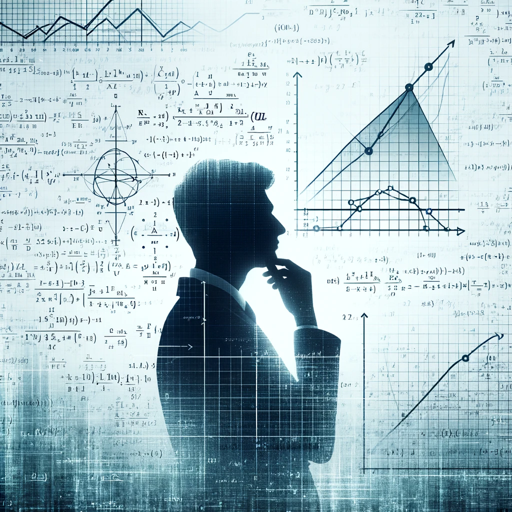Econometrics-econometric analysis tool.
AI-powered econometric insights.
Solve this econometric problem:
How does this concept apply in econometrics?
Explain the methodology behind this analysis.
Calculate the effect of X on Y using the given data.
Related Tools
Load More
Economics Econ
🔷#𝟏 𝐒𝐩𝐞𝐜𝐢𝐚𝐥𝐢𝐳𝐞𝐝 𝐄𝐜𝐨𝐧𝐨𝐦𝐢𝐜𝐬 𝐓𝐮𝐭𝐨𝐫🔷

Economics + Math 📊
Error checking and explanation in Econ and Math. Designed to support learning by simplifying and clarifying complex subjects in these disciplines. It serves as an excellent support for students & professionals in the field. Last updated May 30, Feedback

EconGuru
I might explain econ questions better than your professor!

EconoLab
Economics, econometrics, and data analysis AI.

Econometrics GPT
Expert in econometric theory, providing in-depth teaching for PhD level concepts.

Econometric Analyst
Expert in econometrics, statistical analysis, and economic theory interpretation.
20.0 / 5 (200 votes)
Introduction to Econometrics
Econometrics is the application of statistical methods to economic data in order to give empirical content to economic relationships. It aims to turn theoretical economic models into practical tools for forecasting and policy evaluation. Essentially, econometrics bridges the gap between abstract economic theories and real-world economic practices by using data and statistical techniques to test hypotheses and estimate future trends. For example, an econometric model might be used to determine the impact of education on income levels by analyzing data on education and earnings from various regions.

Main Functions of Econometrics
Estimation of Economic Relationships
Example
Estimating the relationship between consumer income and spending.
Scenario
Using data from household surveys, econometricians can estimate how changes in income levels affect consumer spending habits, which can help businesses and policymakers understand consumer behavior and plan accordingly.
Hypothesis Testing
Example
Testing the hypothesis that higher education leads to higher earnings.
Scenario
By applying statistical tests to data on individuals' education levels and their corresponding incomes, econometricians can test whether the observed relationship between education and earnings is statistically significant and not due to random chance.
Forecasting
Example
Predicting future economic growth based on current and historical data.
Scenario
Econometric models can use data on past economic performance, investment levels, and other relevant variables to forecast future economic growth, aiding governments and businesses in planning for the future.
Ideal Users of Econometrics Services
Academics and Researchers
Academics and researchers benefit from econometrics by using it to test economic theories, validate models, and contribute to the academic body of knowledge. Their work often involves complex data analysis and interpretation, which econometric techniques facilitate.
Government Policymakers
Government policymakers use econometric analyses to inform their decisions on economic policy. For instance, understanding the impact of tax changes on economic behavior, or evaluating the effectiveness of public programs, helps in crafting policies that achieve desired economic outcomes.

Steps to Use Econometrics
Step 1
Visit aichatonline.org for a free trial without login, also no need for ChatGPT Plus.
Step 2
Ensure you have a basic understanding of statistics and econometrics concepts, as they are prerequisites for effective use.
Step 3
Choose a specific econometric model or method based on your research question or data analysis needs.
Step 4
Collect and prepare your data, ensuring it is clean and formatted correctly for the chosen econometric method.
Step 5
Run your econometric analysis using statistical software, and interpret the results within the context of your research.
Try other advanced and practical GPTs
The AI UGC Scripts
AI-Powered UGC Script Creation

PDF to Excel Converter
AI-Powered PDF to Excel Converter

Diagnose This
AI-driven insights for your health questions

GrammarGPT
AI-Powered Grammar Correction

SS
AI-driven solutions for every math problem

Bybit Crypto AI with Real-Time Predictions
AI-powered real-time crypto predictions

Bulba Code Eval Rating Chat Tasks 2
AI-Powered Code and Writing Evaluator

Solicitor AI. Free. (UK)
AI-Powered Legal Guidance Simplified

Finance, Accounting, Budgeting,M&A and taxes
AI-powered financial advisory and management.

Summary Scribe
Condense your content with AI precision.

Ko-Deks-AI:
AI-Powered Assistance for Tech Challenges

HubSbot
Empower Your HubSpot with AI

- Data Analysis
- Academic Research
- Policy Analysis
- Financial Modeling
- Market Forecasting
Econometrics Q&A
What is econometrics?
Econometrics is the application of statistical and mathematical methods to analyze economic data and test hypotheses.
How can econometrics be applied in real-world scenarios?
Econometrics can be applied to forecast economic trends, evaluate policy impacts, and study relationships between economic variables.
What are common econometric methods?
Common methods include regression analysis, time series analysis, and panel data analysis.
Why is data preparation important in econometrics?
Proper data preparation ensures accuracy and reliability of the econometric analysis, avoiding biased or misleading results.
Can econometrics be used for causal inference?
Yes, econometrics is often used to establish causal relationships between variables, using methods like instrumental variables and difference-in-differences.